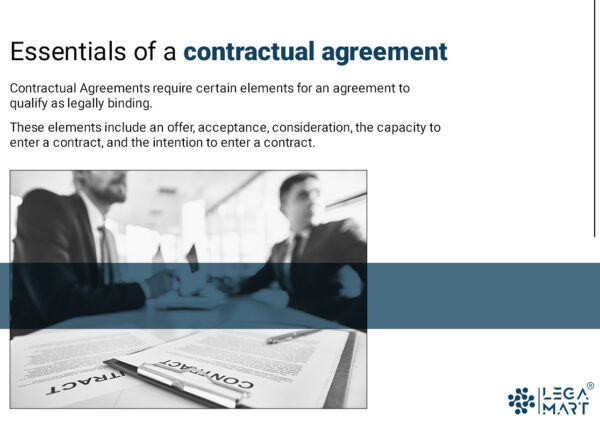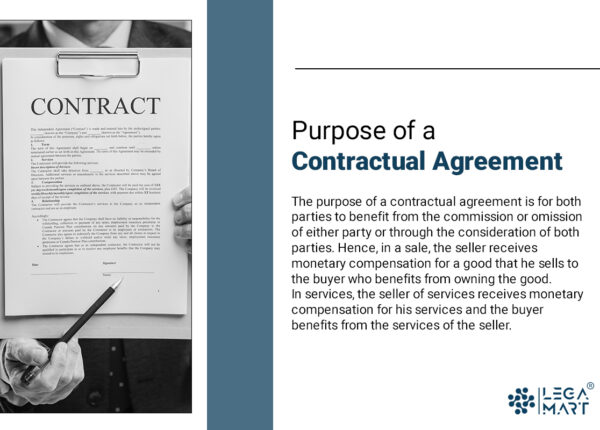Introduction
Let’s suppose two good friends engaged in a conversation regarding a business. Both of them came up with the idea that they would become business partners and work on the business together. A long time passed on this conversation, with neither friend approaching the other for a discussion about what to do.
The friend who initially proposed the idea started his own business disregarding the friend to whom he initially proposed the idea; after getting knowledge about this, the other friend decided to sue the friend for infringing their verbal contractual agreement. The first friend denies that there ever was a legally binding agreement. So the question arises, what is a contractual agreement, and when can we enforce it?
Contractual agreements form the bedrock of legal relationships in the business and personal realms, serving as pivotal instruments that govern the rights, obligations, and interactions between parties. These agreements, rooted in contract law, establish a framework for exchanging goods, services, or promises, providing transaction clarity and security. From intricate business contracts to everyday oral agreements, contractual arrangements underpin the fabric of societal interactions.
They outline terms, conditions, and expectations, delineating the boundaries within which parties operate and offering recourse in case of disputes. The enforceability and validity of contractual agreements often hinge on mutual consent, consideration, legality, and capacity. This dynamic legal landscape ensures that written or oral contracts play a central role in shaping the dynamics of human interactions, fostering trust, and providing a structured framework for the myriad transactions that define our interconnected world.
What is a Contractual Agreement?
A contractual agreement is a legal term often used as a substitute for “contract.” Contractual agreements are enforceable by law; but now the questions comes, what are agreements? An agreement is an offer and acceptance between two or more parties to do or not do something in return for consideration. Normally, agreements do not become contracts until and unless there is a payment of consideration by at least one of the parties.
A design-build contract is a specific contractual agreement used in the construction industry. It is an integrated contract where a single entity, often referred to as the design-builder, is responsible for both the design and construction of a project. The design-build contract outlines the terms and conditions governing this integrated approach.
Essentials of a contractual agreement

Contractual Agreements require certain elements for an agreement to qualify as legally binding. These elements include an offer, acceptance, consideration, the capacity to enter a contract, and the intention to enter a contract. Let us discuss these elements separately:
Offer
An offer is a proposal given by an offeror to an offeree to do or not to do something. An offer can be made in person, through an authorized agent, or remotely through remote communication methods such as mail, Fax, Telex, post, text, email, or any online method. A mere inquiry about something does not amount to an offer and should be explicitly stated. A contractual agreement always has an offer.
Acceptance
An acceptance is an approval of an offer; acceptance is always made by the offeree to the offer given by the offeror. An acceptance can be towards doing or not doing something, i.e., the omission or commission of an act. Acceptance should be explicit and clear, it can be made in person, through an authorized agent, or remotely through remote communication methods such as mail, Fax, Telex, post, text, email, or any online method.
Acceptance, unlike an offer, is considered to be communicated immediately after it has been posted despite the offeror not having any knowledge of the post; however, if an instantaneous method of communication is used, then acceptance is considered to be communicated once the offeror has received the message of acceptance. This rule is also known as the postal acceptance rule and was declared in a famous case known as Adams v Lindsell (1818). When an offer is accepted, an agreement is formed between the parties.
Consideration
Consideration is something that a party gives in return for a promise to do or not to do something or merely the performance of the contract. Consideration is the main element of a contractual agreement that distinguishes a mere agreement from a legally binding contractual agreement. Consideration can be monetary or in the form of actions, either a commission or an omission of an act.
“The consideration must not be past” is a famous legal quote that implies that for an act to be considered as consideration for a promise, it must be done after the promise has been made and not before the promise; two famous cases on this legal principle are Lampleigh v Braithwaite (1615) and Roscorla v Thomas (1842).
In Lampleigh v Braithwaite (1615), a man was convicted of murder who sought assistance from a companion to get a pardon from the King; the companion put in all their efforts and received the pardon, he then proceeded to ask for payment of 100 Pounds, but the convict refused to pay, the court held that he is liable to pay since the actions of the companion amounted to consideration since it was implied that his services were to be paid for and that his actions were only performed after the convict asked.
In Roscorla v Thomas (1842) a man bought a horse from the defendant who, after the purchase was completed, promised that the horse was sound and healthy. Shortly after, it was revealed that the horse was, in fact, not safe and healthy, so the complainant sued for damages while also stating that the defendant promised that his horse was healthy. The defendant held that his promise meant nothing since the contract was completed before the promise was made, and there was no consideration made in response to the promise. The court ruled in favor of the defendants.
Capacity
The “capacity” in legal terminology refers to the ability of a legal person to enter into a contractual agreement. In essence, capacity is a term usually used when an agreement is made with a minor or a legal person that is bankrupt; in both cases, the legal persons are not qualified to form contractual agreements with anyone.
Hence, if anyone under 18 forms a contractual agreement, they are not legally bound by this contract and if someone makes a contractual agreement while being bankrupt, they are not essentially capable of contracting so it is not legally binding on them but due to circumstances of the case and characteristics of the bankrupt, the contract may be enforced. However, most likely, the outcome of such cases is a rescission of the contract, which means putting both parties in their pre-contractual positions.
Intention
The “intention” refers to the objective or aim of a person to enter into a contractual agreement with the other party. Without intention, it is really difficult to prove that a contractual agreement exists. Usually, the cases of intention are based on duress which is the forcing of a party to enter into a contract; contractual agreements cannot be made under duress due to the sole reason that the party did not have any intention of entering into the contractual agreement in the first place.
The reason why, in the initial example, the judge might dismiss the case, is that it is implied that people who form “social agreements” do not intend to enter into legally binding contractual agreements. Since the two were friends and were not serious initially, it can be implied that they formed a social agreement.
Difference between Void, Voidable and Unenforceable contract
Void contract
This is fundamentally unenforceable and lacks legal validity from the beginning, essentially treated as if it never existed. Such contracts are deemed null and void by the law. Various situations lead to the classification of a contract as void: engaging in illegal activities (e.g., selling stolen goods), lack of legal capacity (e.g., involving a minor who cannot enter legally binding contracts), the death of a party before contract fulfilment, or circumstances making it impossible to perform the contract terms due to unforeseen events. The contract is rendered void in each of these instances, underscoring the principle that it is legally invalid and unenforceable.
Voidable contract
This provides a party with the option to undo the contract entirely from the start. Choosing this course of action renders the contract ‘void ab initio,’ essentially treating it as if it never existed. Notably, the party also has the alternative option to ‘affirm’ the contract. Opting for affirmation means the contract remains valid and enforceable, allowing for remedies like specific performance. Moreover, if the other party fails to fulfil their obligations, it constitutes a breach, providing the party with grounds to pursue damages claims. In essence, the voidable nature of the contract provides flexibility for the affected party to either invalidate the agreement or choose to uphold and enforce it, depending on their preferences and circumstances.
Unenforceable contract
This one cannot be enforced in a court of law, yet it may still be considered valid. The essential characteristic is that, due to specific legal issues, it cannot be brought before a court for enforcement. An illustrative example of unenforceable contracts is those involving illegality. If a contract is inherently illegal, it is not enforceable because the law prohibits such agreements. In other words, the nature of the contract goes against legal principles, making enforcement through legal channels impossible. While the contract might technically exist, the legal system will not provide remedies or enforcement for its terms due to the inherent illegality involved.
Purpose of a Contractual Agreement

The purpose of a contractual agreement is for both parties to benefit from the commission or omission of either party or through the consideration of both parties. Hence, in a sale, the seller receives monetary compensation for a good that he sells to the buyer who benefits from owning the good. In services, the seller of services receives monetary compensation for his services and the buyer benefits from the services of the seller.
Types of Contractual Agreements
There are mainly two types of contractual agreements, unilateral contractual agreements, and bilateral contractual agreements. In unilateral, only one party assumes the obligation of performing under a contract and is often made to a general group of people or the public at large; an example of a public reward for the reporting of a missing article or person can be given, only the person who posted the public notice is assuming obligation under the contract.
In bilateral contractual agreements, both parties mutually agree to perform their obligations under the contract. Both the offeror and the offeree, after forming the contract, are legally bound to follow the contract. The majority of contracts fall under this category.
Contracts are written and can be made verbally where the conduct of the parties or witnesses may be used as evidence of the existence of a contractual agreement between two parties. Contracts can also be implied or explicit whereby the parties implicitly point that they have entered into a contractual agreement e.g. when we buy things at a shop, we bring them to the counter where the employee scans them and we pay for them without uttering a word; this is an example of an implicit contractual agreement, whereas, in explicit contracts, the parties enter into a conversation and explicitly agree on the terms of a contract.
The negotiation of contractual terms does not amount to the completion of a contractual agreement and oftentimes, a possible contract may be dropped during the negotiating phase without legal consequences. Basically, during the negotiation phase, an offer is followed by a counter-offer and no acceptance is made, hence a contractual agreement is finally made once a party communicates acceptance to the other party’s terms.
Vitiating Factors of a Contract
A vitiating factor undermines the legal impact of a contract, usually affecting the voluntary agreement between parties. Simply put, a valid contract relies on the willing agreement of two or more parties. Vitiating factors, according to standard contract theory, relate to issues with the consent of the parties.
So, when do vitiating factors make contracts unenforceable, and what are the main factors that contracting parties should be aware of?
Misrepresentation: One major vitiating factor is misrepresentation, which involves a false or misleading statement that leads a party into a contract. This goes beyond mere opinions shared by the other party and can imply that the deceived party didn’t fully understand the true nature of the contract.
There are three types of misrepresentation:
- Negligent Misrepresentation: Applies when none of the first two options are met. It is typically found when the party making the statement cannot prove they had reasonable grounds to believe it was true. The remedy is similar to fraudulent misrepresentation. Negligent misrepresentation can also be established under common law when there’s a special relationship between the parties, leading to a duty of care, and the remedy is damages based on the tort of negligence.
- Innocent Misrepresentation: Occurs when the party making the statement can prove they had reasonable grounds to believe, up to the time of the contract, that the facts represented were true. Remedies include rescission or damages based on standard contractual principles.
- Fraudulent Misrepresentation: Happens when the party making the statement knows it is false, does not believe it, or is reckless about its truth. Remedies involve rescission and/or damages covering all losses stemming from the misrepresentation, including consequential ones.
Illegality: Illegality in contracts is a concept that underscores why individuals involved in illegal activities don’t typically resort to legal action when agreements are breached. It goes beyond distrust of legal institutions; it’s rooted in the understanding that contracts formed for illegal purposes or featuring illegal terms are unenforceable. In essence, these contracts are deemed illegal. The same principle applies to contracts with purposes contrary to public policy, like an agreement for the purchase of stolen goods; they are inherently invalid and cannot be legally enforced. This legal principle is a deterrent, discouraging individuals from seeking legal remedies when their agreements involve illegal or morally objectionable activities.
Mistake: In the realm of contract mistakes, three scenarios may unfold:
- Mutual Mistake: Occurs when the parties misunderstand each other’s intentions, yet each believes the other agrees on the contract terms or subject matter.
- Common Mistake: Arises when both parties share the same misconception about the subject matter, ownership of property, or the quality of the subject matter.
- Unilateral Mistake: This occurs when one party is mistaken about the identity of the other party, contract terms, or the nature of a signed document. The other party is typically aware of this mistake and may take advantage of it.
Duress: This involves using threats or illegitimate pressure to coerce a party into a contract, rendering the contract voidable.
Undue influence: This occurs when a position of power is improperly used to pressure a party into a contract. While not as severe as duress, it still compromises a party’s free and informed consent. It is presumed in certain relationships with an acknowledged power imbalance, like solicitor-client relationships. In other cases, actual undue influence must be demonstrated.
Unconscionability: This refers to the unfair exploitation of unequal power to induce a party into a contract. If the contract terms heavily favour the more powerful party and are morally reprehensible, enforcing the contract would go against good conscience. In suspected unconscionable conduct, the more powerful party must demonstrate that the contract is fair, just, and reasonable.
Capacity: This is relevant when a party legally incapable of entering into a contract, such as a minor, does so. In such cases, the contract is voidable.
Examples of When to Use a Contractual Agreement

Contractual agreements are the ultimate tool to legally bind another party to perform an obligation. Hence, from the sale of goods to the performance of services, everyone should form contractual agreements so that they can legally bind others to perform their obligations under the contract.
Real Estate Transactions
It is a legal agreement between a buyer and a seller that outlines the terms and conditions of a real estate transaction. The contract includes information about the property being sold, such as its location, size, and features, as well as the purchase price, the closing date, and any contingencies, such as a home inspection contingency or a financing contingency. In order to protect their interests, both parties should carefully review and understand the terms and conditions outlined in the contract before signing.
Business Partnerships
It is a contract between partners in a business partnership that outlines the terms and conditions of the partnership. This agreement is used to establish the roles and responsibilities of each partner, the distribution of profits and losses, and the procedures for dissolving the partnership. A partnership agreement is an important tool for protecting the interests of each partner and ensuring that the partnership runs smoothly. It can also help to minimize the risk of disputes arising between partners.
Employment Relationships
An employment contract is a legal agreement between an employer and an employee that outlines the terms and conditions of the employment relationship. This contract has information about the job responsibilities, compensation, and benefits. It is important to clearly define the terms and conditions of an employment relationship, as this can have significant legal and financial implications, including liability for taxes, benefits, and employment-related laws.
Leasing Arrangements
A lease agreement is a legal agreement between a landlord and a tenant that outlines the terms and conditions of a rental arrangement. This contract includes information about the rental amount, the length of the lease, and any restrictions on the use of the property, such as pet policies or parking regulations. It is essential to carefully review and understand the terms and conditions outlined in a lease agreement before signing, as this contract is binding and enforceable under law.
Construction Projects
A construction contract is a legal agreement between a builder and a client that outlines the terms and conditions of a construction project. This contract includes information about the scope of work, the payment terms, and the timeline for completion.
What Should Be Included in a Contractual Agreement?
Mainly the contracts between parties mention who the buyer/seller/offeror/offeree is and what the terms of the contract are; they should also mention the age, identity, address, description of goods or services, and all other relevant clauses that are important for the performance of the parties. However, in case something has been missed from a contract, it can later be added through verbal contractual agreements or can be set up in separate contractual agreements.
Get Help with Contractual Agreements
In case you are experiencing any problem with a contractual agreement formed or if you want to draw up a contractual agreement, LegaMart is always here to assist you in your endeavors.
LegaMart is always here to provide quality information and articles to the general public as well as quality legal counseling services.
Conclusion
In summary, a well-drafted contractual agreement is a crucial tool for establishing a clear understanding of the expectations, responsibilities, and obligations of the parties involved in a business relationship. By including essential elements such as the identification of the parties, the object of the contract, obligations, duration, confidentiality provisions, dispute resolution, and governing law, a contractual agreement helps to minimize misunderstandings, reduce the risk of disputes, and ensure that the parties are protected.
Whether you seek assistance from an attorney, use online templates, or work with a contract management service, it is important to carefully review the agreement before signing to ensure that it accurately reflects your understanding of the terms and conditions of the business arrangement.
FAQs
Is a Void and a Voidable Contract Enforceable?
In the UK, void contracts lack enforceability as they are deemed null and void by law, and courts refrain from intervening to enforce any terms, aligning with a fundamental principle of contract law to avoid upholding illegal or unenforceable agreements. On the contrary, voidable contracts are considered valid and enforceable, but the party affected by defects in the contract can reject it. If the affected party chooses not to reject the contract despite its issues, it remains valid and enforceable.
What is an Oral Contract?
An oral contract is an agreement between two or more parties made through spoken words rather than a written document. No written agreement is produced, but both parties agree on terms verbally.
Is an Oral Contract Enforceable?
Generally, yes, an oral contract is enforceable, though it may be challenging to prove. The enforceability depends on the jurisdiction where the contract may be contested and the type of agreement it relates to.
What Are the Disadvantages of Oral Contracts?
The primary disadvantages include:
- Difficulty in enforcement.
- Potential for confusion and error.
- Inconsistency with the agreed terms.
Because oral contracts rely on spoken words, enforcing them in court can be challenging if a party fails to uphold their end of the deal, leading to increased risk in the contract.




